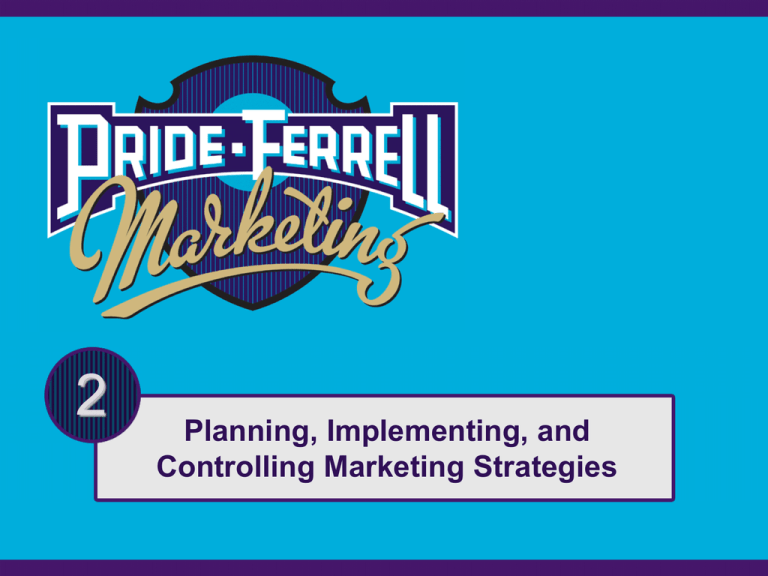
2
Planning, Implementing, and
Controlling Marketing Strategies
Agenda
• Understanding the Strategic Planning
Process
• Assessing Organizational Resources and
Opportunities
• Establishing an Organizational Mission and
Goals
• Developing Corporate, Business-Unit, and
Marketing Strategies
• Creating the Marketing Plan
• Implementing Marketing Strategies
Copyright © Houghton Mifflin Company. All rights reserved.
2 | 2
Understanding the Strategic Planning
Process
Strategic
Planning
The process of
establishing an
organizational
mission and
formulating goals,
corporate strategy,
marketing objectives,
marketing
strategy, and a
marketing plan
Marketing
Strategy
A plan of action for
identifying and
analyzing a target
market and
developing a
marketing mix to
meet the needs of
that market
Copyright © Houghton Mifflin Company. All rights reserved.
Marketing
Plan
A written document
that specifies
the activities to be
performed to
implement and
control an
organization’s
marketing activities
2 | 3
Components of Strategic Planning
Source: Figure adapted from Marketing Strategy, Second Edition, by O. C. Ferrell, Michael Hartline, and George Lucas, Jr.
Copyright © 2002. Reproduced with permission of South-Western, a division of Thomson Learning.
Copyright © Houghton Mifflin Company. All rights reserved.
FIGURE 2.1
2 | 4
Assessing Organizational Resources and
Opportunities
• Core Competencies
– Things a firm does extremely well
(strengths), which sometimes give it an
advantage over its competition
• Unique skills (manufacturing process,
marketing ability, R&D)
• Financial and human resources
• Reputation, goodwill, and brand names
Copyright © Houghton Mifflin Company. All rights reserved.
2 | 5
Assessing Organizational Resources and
Opportunities (cont’d)
• Market Opportunity
– A combination of circumstances and timing
that permits an organization to reach a
target market
• Core competencies are matched to
opportunities: competitive advantage
• Strategic windows—
temporary periods of optimal
fit between the key requirements
of a market and the particular
capabilities of a firm
Copyright © Houghton Mifflin Company. All rights reserved.
2 | 6
Assessing Organizational Resources and
Opportunities (cont’d)
• Competitive Advantage
– The result of a company’s matching
a core competency (superior skill
or resources) to opportunities
in the marketplace
• Manufacturing skills
• Technical skills
• Marketing skills
Copyright © Houghton Mifflin Company. All rights reserved.
2 | 7
SWOT Analysis
• An assessment of the organization’s
strengths, weaknesses, opportunities, and
threats
– Strengths—competitive advantages or core
competencies
– Weaknesses—limitations on competitive
capability
– Opportunities—favorable conditions in the
environment
– Threats—conditions or barriers to reaching
objectives
Copyright © Houghton Mifflin Company. All rights reserved.
2 | 8
The Four-Cell SWOT Matrix
Source: Reproduced from Nigel F. Piercy, Market-Led Strategic Change. Copyright © 1992, p. 371, with
permission from Elsevier Science.
Copyright © Houghton Mifflin Company. All rights reserved.
FIGURE 2.2
2 | 9
Establishing an Organizational Mission and
Goals
• Mission Statement
– A long-term view, or vision, of what the
organization wants to become
– Mission statement answers two questions:
• Who are our customers?
• What is our core
competency?
“The Library's mission is to make its resources available and
useful to the Congress and the American people and to sustain and
preserve a universal collection of knowledge and creativity for
future generations.” – Library of Congress
Copyright © Houghton Mifflin Company. All rights reserved.
2 | 10
Establishing an Organizational Mission and
Goals (cont’d)
• Marketing Objective
– A statement of what is to be accomplished
through marketing activities to match
strengths to opportunities, or to provide for
the conversion of weaknesses to strengths
• Should be stated in clear, simple terms
• Should be accurately measurable
• Should specify a time frame for
accomplishment
• Should be consistent with business-unit and
corporate strategy
Copyright © Houghton Mifflin Company. All rights reserved.
2 | 11
Corporate Strategy
• A strategy that determines the means
for utilizing resources in the various
functional areas to reach the
organization’s goals
–
–
–
–
Determines the scope of the business
Guides its resource deployment
Identifies its competitive advantages
Provides overall coordination of functional
areas
Copyright © Houghton Mifflin Company. All rights reserved.
2 | 12
Corporate Strategy (cont’d)
• Issues Influencing Corporate Strategy
Development
–
–
–
–
–
–
Corporate culture
Competition
Differentiation
Diversification
Interrelationships among business units
Environment concerns and social issues
Copyright © Houghton Mifflin Company. All rights reserved.
2 | 13
Business-Unit Strategy
• Strategic Business Unit (SBU)
– A division, product line, or other profit center
within a parent company
• Market
– A group of individuals and/or organizations that
have needs for products in a product
class and have the ability,
willingness, and authority to
purchase those products
• Market Share
– The percentage of a market that
actually buys a specific product
from a particular company
Copyright © Houghton Mifflin Company. All rights reserved.
2 | 14
Business-Unit Strategy (cont’d)
• Market-Growth/Market-Share Matrix
– A strategic planning tool based on the
philosophy that a product’s market growth
rate and market share are important in
determining marketing strategy
– Factors determining SBU/product’s
position within a matrix
• Product-market growth rate
• Relative market share
Copyright © Houghton Mifflin Company. All rights reserved.
2 | 15
Growth-Share Matrix Developed by the
Boston Consulting Group
Source: “The BCG Portfolio Matrix” from the Product Portfolio Matrix, © 1970, The Boston Consulting
Group. Reproduced by permission.
Copyright © Houghton Mifflin Company. All rights reserved.
FIGURE 2.4
2 | 16
Business-Unit Strategy (cont’d)
• Market-Growth/Market-Share Matrix (cont’d)
– BCG Classification
• Star—high growth market, dominant market share
– requires additional resources for continued growth
• Cash cow—low growth, dominant market share
– generates surplus resources for allocation to other SBUs
• Dog—low/declining market, subordinate market share
– has diminished prospects and represents a drain on the
portfolio
• Question mark—high growth market, low market share
– represents a high-risk/cost opportunity requiring a large
commitment of resources to build market share
Copyright © Houghton Mifflin Company. All rights reserved.
2 | 17
Using BCG’s Market Growth/Market Share
Matrix, how would you classify the following
products?
1.
2.
3.
4.
5.
6.
7.
8.
9.
10.
Chrysler/Dodge minivans
LP records
Levi’s blue jeans
AirTran
Windows XP
Pizza Hut Pan Pizza
Miller Light
Tampa Bay Buccaneers
Digital video discs
Black and white televisions
Copyright © Houghton Mifflin Company. All rights reserved.
2 | 18
Marketing Strategy
• Target Market Selection
– Defining/understanding the target market by
• focusing on specific profitable customer groups/market
segments.
• recognizing changes occurring in the market.
• Creating the Marketing Mix
• Analyze customer needs, preferences, and behavior
• Have the skills and resources required for product
design, pricing, distribution, and promotion
• Maintain strategic consistency and flexibility in
marketing mix decisions
Copyright © Houghton Mifflin Company. All rights reserved.
2 | 19
Dannon yogurt
targets the female
segment of the
population on a low
carbohydrate diet.
© 2004 The Dannon Company, Inc. All rights reserved. Reprinted with
permission.
Copyright © Houghton Mifflin Company. All rights reserved.
2 | 20
Creating the Marketing Plan
• Marketing Planning
– The systematic process of assessing
opportunities and resources, determining
objectives, defining strategies, and
establishing guidelines for implementation
and control of the marketing
program
Copyright © Houghton Mifflin Company. All rights reserved.
2 | 21
Creating the Marketing Plan (cont’d)
• Benefits of Planning
– Provides the basis for internal
communication among employees
– Defines the assignment of responsibilities
and tasks and sets the schedules for
implementation
– Presents objectives and specifies resource
allocations
– Helps in monitoring and evaluating the
performance of the marketing strategy
Copyright © Houghton Mifflin Company. All rights reserved.
2 | 22
Copyright © Houghton Mifflin Company. All rights reserved.
2 | 23
Implementing Marketing Strategies
• Marketing Implementation
– The process of putting marketing strategies into
action
• Intended Strategy
– The strategy that the company decides on during
the planning phase
• Realized Strategy
– The strategy that actually takes place
Intended
Strategy
Implementation
Copyright © Houghton Mifflin Company. All rights reserved.
Realized
Strategy
2 | 24
Approaches to Marketing Implementation
• Internal Marketing
– Internal customers
• A company’s employees
– Coordinating internal exchanges between the firm
and its employees to achieve successful external
exchanges between the firm and its customers
– Helping employees understand and accept their
roles in the marketing strategy
• External Marketing
– External customers
• Individuals who patronize a business
Copyright © Houghton Mifflin Company. All rights reserved.
2 | 25
A
Framework
for Internal
and
External
Marketing
Source: Adapted from Nigel F.
Piercy, Market-Led Strategic
Change, Copyright © 1992,
Butterworth-Heinemann Ltd.,
p. 371. Used with permission.
Copyright © Houghton Mifflin Company. All rights reserved.
2 | 26
Organizing Marketing Activities
• The Role of Marketing in an Organization
Understanding customer
needs and desires
Organizational goals for
customer value and firm
profitability
Marketing Concept
Close coordination of organizational units
Copyright © Houghton Mifflin Company. All rights reserved.
2 | 27
Traditional Versus Marketing-Oriented
Organizations
Copyright © Houghton Mifflin Company. All rights reserved.
2 | 28
The Marketing Control Process
FIGURE 2.5
Copyright © Houghton Mifflin Company. All rights reserved.
2 | 29
Controlling Marketing Activities
• Marketing Control Process
– Establishing performance standards and trying to
match actual performance to those standards
• Establishing Performance Standards
– Expected levels of performance
• Taking Corrective Action
– Improve actual performance
– Reduce or change the performance standards
– Do both
Copyright © Houghton Mifflin Company. All rights reserved.
2 | 30
Controlling Marketing Activities (cont’d)
• Problems in Controlling
Marketing Activities
– Lack of the information
required to control activities
– Uncontrollable influence of market
environment changes on marketing
activities
– Time lag that occurs between marketing
campaigns and their results delays
corrective actions
Copyright © Houghton Mifflin Company. All rights reserved.
2 | 31







